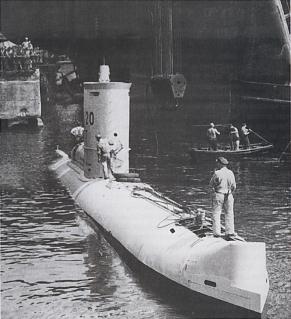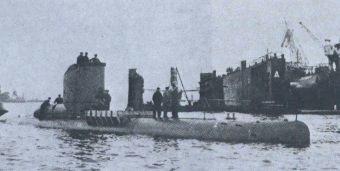

|
Type XXIII U-Boat
 |
|
|
|
|
Authored by Uboataces |

|
By 1941, except for six remaining Type II coastal boats operating in the Black Sea, all other Type II coastal boats had been withdrawn from operational service and relegated to training duties. When development of the Type XXI Elektroboat began in late 1942, a proposal was put forward to also develop a smaller cousin of the Elektroboat which would incorporate the same technological advances and was intended to replace the role of the Type II coastal boat. Donitz, however added two further requirements, which was the boat should have to operate in the Mediterranean and Black Sea theaters, which meant it had to be transportable by rail and it had to use the standard 21 inch torpedo tubes.
The development of the Type XXIII was given very high priority, with the emphasis on using existing well-tried components as much as possible. To reduce development time, Dr. Walter designed the new boat based on the previous Type XXII prototype. By June 30 1943, the initial design was ready and construction began in parallel at several shipyards in Germany, France, Italy and German occupied USSR. The lead contractor was Deutsche Werft in Hamburg.
As with the Elektoboat, construction of this advanced submarine faced a logistical nightmare. Many disruptions were caused by Allied land advances, constant aerial bombings, material and manpower shortages. The first Type XXIII to roll off the assembly line was U-2321 launched on April 17 1944 and commissioned on June 12 1944. Of the 280 submarines ordered, only 61 had entered service, of which only six had ever carried out a war patrol.

The Type XXIII had an all welded single hull design, and was the first submarine in the world to use a single hull design. It had a full streamlined outer hull and apart from the relatively small bridge and a hump on its back which housed the diesel exhaust silencer, there was a complete absence of clutter on the upper deck. Inline with Walters design, there was no forward hydroplanes, although this was added later. The Type XXIII was propelled by a single three-bladed propeller and steered by a single rudder; with the tail of the submarine tapered off to a knife-edge. The cross section of the forward pressure hull resembled the form of a figure of eight. As in the Type XXI, the lower section was used to house a large 62-cell battery. The aft pressure hull was cylindrical in shape which also housed the fuel tanks and ballast tanks.
In order for the boat to be transportable by rail, this meant that sectionalized parts of the hull were limited in size in order to fit into the standard rail car compartment. During transportation, the hull was broken into four sections and the bridge was removed before being loaded onto a rail car. Due to space restriction, the forward bow section had to be kept as short as possible, with the consequence that only two torpedo tubes could be carried. In addition, the limited bow space meant that no spare torpedoes could be carried. In order for the torpedoes to be loaded, the boat had to be ballasted down at the stern, so that the bow was lifted clear of the water. A barge could then load the torpedoes externally. No reloads at sea could be carried out.
For the power plant, the Type XXIII used the MWM RS-348 diesel engine, which was already in use as a diesel generator aboard the Type IXDs. The electric motor was the AEG GU 4463/8, which was a simplified version of the electric motors employed on the Type VIIs. As with the Type XXI Elektroboat, there was a creep motor which could either be used for super silent operation or as a generator to charge the batteries while snorkeling. It was intended for all Type XXIIIs to be coated with Alberich, but in the event only four boats received the coating.
Handling wise, the Type XXIII proved to be an excellent boat, which was highly maneuverable both on the surface and underwater. Crash dive time was a quick 9 seconds, although the crew had to react quickly not to exceed its maximum diving depth of 180 meters. Underwater speed was 12.5 knots, while surface speed was just over 9 knots. While snorkeling, the boat could travel up to a maximum of 10.5 knots.
Operational History
The first Type XXIII launched was U-2321 on April 17 1944. By the end of the war, a total of 61 Type XXIIIs had entered service, with the last one launched on April 19, 1945 (U-4712). Only six boats are known to have carried out operational patrols, which resulted in five Allied ships sunk with no loss to the attacking boats.

|
| Together with the Type XXI Elektroboat, Donitz had pinned his hopes on these two advanced submarines to restore the initiative back to the Kriegsmarine. Seen above is a Type XXIII in its berth. |
The U-2336 (Klusmeier) sank the Avondale Park at 2300 on May 7 1945, which achieved the unfortunate distinction of the last enemy merchant ship sunk during the Battle of the Atlantic.
Seven Type XXIIIs were sunk before reaching full operational status :-
- U-2331 Oct 10 1944, disappeared while on training in the Baltic; cause unknown
- U2342 Dec 26 1944, hit a mine in the Baltic
- U-2344 Feb 18 1945, sunk after collision with U-2366 while on training in the Baltic
- U-2359 May 12 1945, sunk by British aircraft in the Kattegat
- U-2338 May 4 1945, sunk by British aircraft in the Baltic
- U-2367 May 5 1945, sunk after collision with another U-boat in the Green Belt area
- U-2365 May 5 1945, sunk by British aircraft in the Kattegat
Thirty one were scuttled at the end of the war, twenty were surrendered to the Allies and only three survived the war (U-2326, U-2353 and U-4706).
Technical Specification
| Type XXIII | |
| Role | Long Range Coastal Submarine |
| Displacement Surfaced Submerged |
234 tons 275 tons |
| Dimensions Length Beam Draught |
113.8ft (34.7m) 9.8ft (3.0m) 25.3ft (7.7m) |
| Top speed Surfaced Submerged Snorkel Silent |
9.7 knots 12.5 knots 10.75 knots 4.5 knots |
| Maximum range Surfaced at 8kt Submerged at 4kt |
2600nm 194nm |
| Crush depth | 591ft (180m) |
| Crash dive | 9 seconds |
| Engines Diesel Electric Creep motor Battery |
One MWM 6 cylinder, 4-stroke RS-34-S; 630hp One AEG GU 4463-8 double-armature; 572hp One BBC GCR-188 single-cummutator electric motor; 35hp One 62-cell AFA 2 x 21 MAL-740E battery; 5,400 amp/hour |
| Weapons Bow tubes Stern tubes Torpedo capacity Mines Guns |
Two 21 inch None Two None None |
| Officers and crew | 2 + 12 = 14 |
| Total ordered | 280 (61 built) | First launch | April 17, 1944 |



